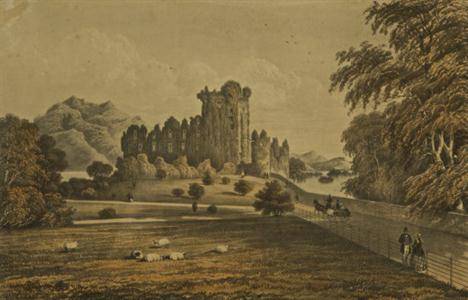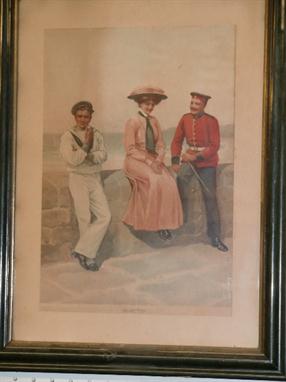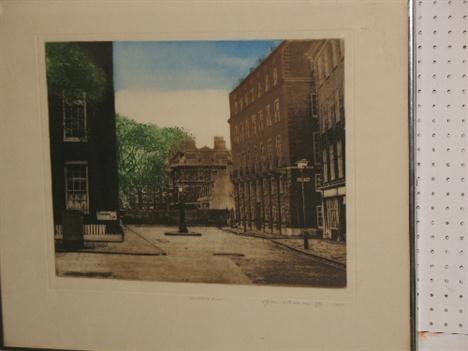We found 314796 price guide item(s) matching your search
There are 314796 lots that match your search criteria. Subscribe now to get instant access to the full price guide service.
Click here to subscribe- List
- Grid
-
314796 item(s)/page
*SIR KYFFIN WILLIAMS, R.A. (1918-2006) Shepherds linocut print, printed by David Vickers, proof, pencil signed `Kyffin W`; unframed Pl. 7 1/4 x 5in; an unframed wood engraving by Howard Phipps depicting Wiseman`s Wood (1987); a signed linocut of a Norfolk Beach by N.J. Jackson ,numbered 1/150; and a book titled `Miscellany` published by The Curwen Press 1931; four (4)
* Arthur Pond, British 1701-1758 and Charles Knapton, British 1698-1778- "Pond And Knapton`s Imitations of Drawings" Album of Engravings and Chiaroscuros, after Annibale Carracci, Rembrandt, Guercino and others, 52x35cm Note: In 1735 and 1736 the artist and printseller Arthur Pond and publisher Charles Knapton began to reproduce seventy prints in chiaroscuro of old-master drawings in the most important of British collections. The selection of drawings representing fashionable taste among British collectors in the 1730`s and significantly indicates the ownership of each drawing in accompanying engraved captions. Collectors include Jonathan Richardson, Arthur Pond, Richard Houlditch, Hugh Howard, Dr. Richard Mead, Lord James Cavendish, Thomas Hammer, and one each from Robert Dingley, John Guise, Capt. John Campbell, Sir Hans Sloane and others. The drawings chosen are predominantly Italian in the taste of the Grand Tour, by such artists as Guercino, Agosto and Annibale Carracci, Parmigiano, Panini, G. J. Grimaldi and Bolognese, Raphael, Mantegna and others. No title and list of the drawings was included by Pond and Knapton in 1735-1736 and very few complete sets issued by them have remained together. There is strong evidence in Pond`s journals and accounts that the prints were mostly sold in singles or distributed to other print dealers in England.
Harold Riley (b.1934)-a signed limited edition sepia print of a named seated female figure, no.3/5, dated 1987, 38x29cm, together with two further studies of the same image with artists annotations, also including a monogrammed colour portrait print depicting a lady of repute, her back to the artist looking towards a lorry (4)
Thomas Snagg (1746-1812) VIEW OF CLONTARF CASTLE, 1805 oil on canvas signed and dated lower right 60.96 by 91.44cm., 24 by 36in. L "Stackallan House Co. Meath Sale, Christie`s, 20 October, 1992, lot 197; Private collection This rare Thomas Snagg oil painting places its main feature- Clontarf Castle - on the left-hand side of the picture, a characteristic also found in the works of his exact contemporary William Ashford who had dominated Irish landscape painting for a quarter of a century before Snagg put brush to canvas here in 1805. The castle stands on the site of the Norman fortress built around 1200 by the Knights Templar and the tower at the right-hand end of the building may be part of a later medieval commandery of the Knights Hospitallers to whom the property was transferred in the 14th century. The remainder of the castle seen in Snagg`s canvas is probably a creation of the later18th century; one of the earliest examples of the Neo-Gothic style in Ireland, and the predecessor of the present Tudor-Revival structure designed by William Vitruvius Morrison in 1836. A closer view of 1772 by Gabriel Beranger, of which there is a watercolour copy in the National Library, shows out the Gothic fenestration more clearly. In 1998, Sotheby`s auctioned for £40,000 a sketch of the castle of around 1817, allegedly by the famous English painter J.M.W. Turner, which was apparently copied from an original by Maria Sophie Vernon. She was a member of the family which had been in residence since the mid-17th century - the builders of the structure painted by Snagg - and whose name is still attached to the various roads in the vicinity. It is doubtless they or their guests feature in the charming vignette in the bottom of the picture, seen on the horse-drawn carriage at the top of the road leading down to the sea.The right half of the picture gives a break in the foliage to reveal a splendid vista of Dublin Bay, reaching as far as the two Sugarloaves - Dunleary (afterwards, Kingstown and later Dún Laoghaire) before its harbour was built. A notable feature is the South Wall, finished in 1786, and extending from Ringsend (out of sight) past the Pidgeon house out to the old Poolbeg Lighthouse which helped guide shipping up the River to the Custom House, completed only fourteen years before Snagg`s panorama was created. A most unexpected, and rather fanciful, feature of the picture is the series of houses and other buildings presented at such a scale as to be almost Lilliputian, and placed along the shore where there were probably slobs at the time, a plan to reclaim which was prepared in the year of the painting, 1805. Snagg, thrice married, was born in London and became a successful actor, performing with David Garrick at Drury Lane. He took up painting around the mid-1770s and travelled as far as St. Petersburg, where he painted Empress Catherine the Great. On his return journey, Robespierre arrested him and his family in northern France, where he was held captive for more than a year - an ordeal he recorded in a print in the British Museum.In 1804, twelve months before he painted Clontarf, Snagg exhibited four landscapes at Allen`s in Dame Street, one of which may have been the view of Dublin Bay seen from the University Rowing Club in Ringsend now in the National Gallery of Ireland, and which - like the Clontarf picture - has the main building on the left-hand side of the painting.Dr. Peter HarbisonHonorary Academic Editor, Royal Irish AcademyFebruary, 2012
Edwards James Rogers (1872-1938) ROCHES POINT FROM GLENBROOK, CORK, c.1929-1932 oil on canvas board signed lower right; signed again and with title and price on original label on reverse; also with John Gilbert, Print Seller & Framer label [120 Patrick Street, Cork] on reverse 29.21 by 49.53cm., 11.5 by 19.5in. L "Son of a Dublin-born architect, E. J. Rogers exhibited regularly at the RHA from several Dublin addresses including Rathgar, Terenure, Dún Laoghaire among others and, between 1929 and 1932, from Bellevue, Glenbrook, Cork, where this is painting set. Snoddy notes that he attended the Crawford School of Art in 1893. Two of his etchings are in the National Library of Ireland (For further reading see Snoddy, pp.573-4) Contained in its original frame.
-
314796 item(s)/page













































